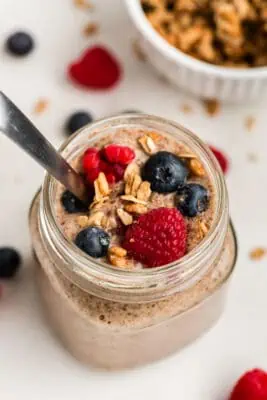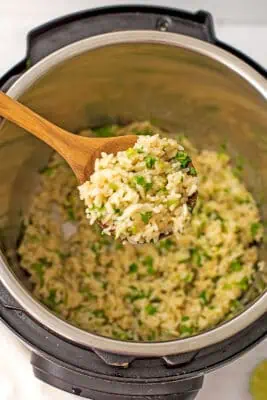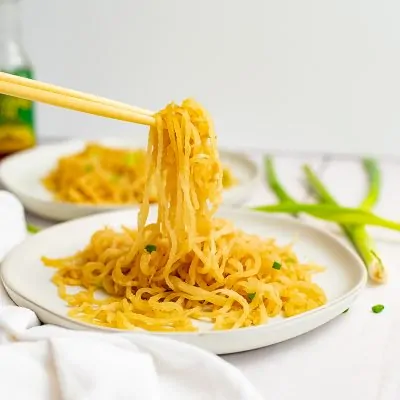Veggie Pesto Pasta
Veggie pesto pasta is so flavorful and filling. This simple pesto vegetable pasta recipe is a great use for summer produce and the perfect simple weeknight meal or lunch meal prep. Ready in about 20 minutes, this veggie pesto pasta recipe can be made even quicker by using storebought pesto and no cook veggies.
If you love pesto pasta recipes, be sure to check out this Mushroom Pesto Pasta or Pesto Tuna Pasta.
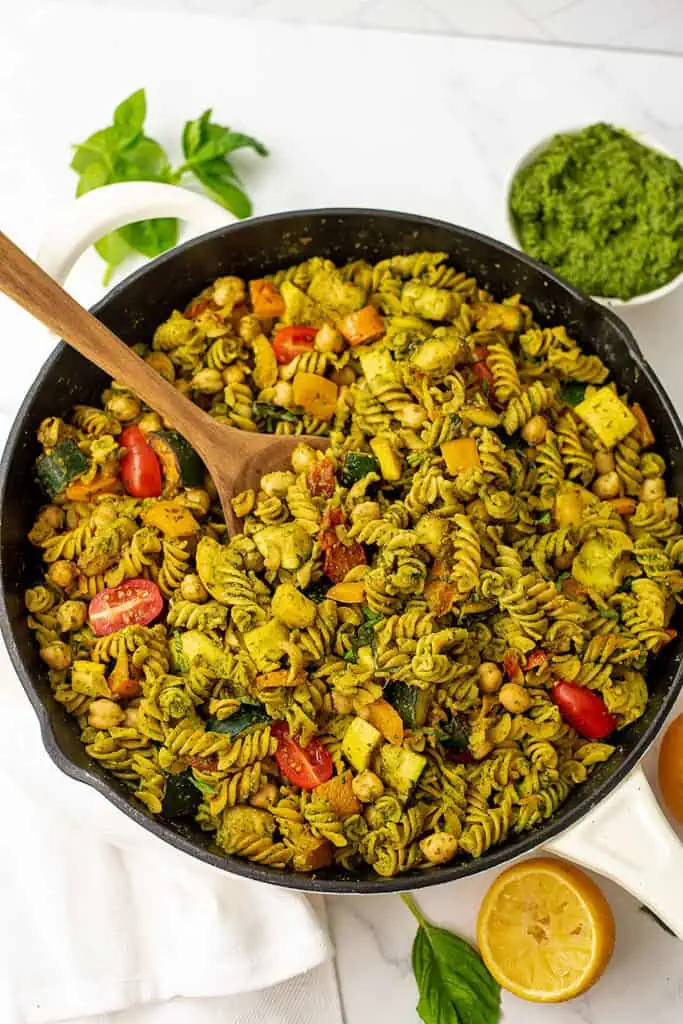
The best pesto vegetable pasta salad
This healthy pasta recipe doesn’t require a ton of effort but is packed with flavor. This meatless meal is so filling thanks to the high fiber lentil or chickpea pasta.
Pesto primavera pasta is a great recipe to use up that summer produce, but really it’s so customizable you can uses whatever vegies you have on hand and creates a delicious meal.
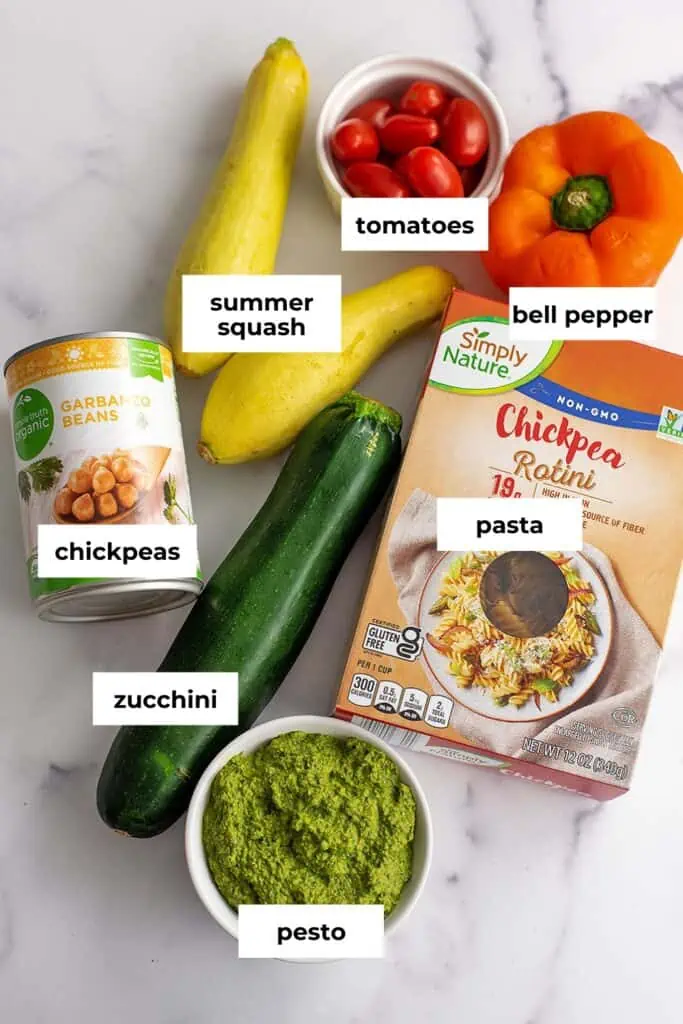
Ingredients
- Zucchini and Summer Squash
- Bell peppers
- Tomatoes
- Pasta – (I love Tolerant brand legume based pastsa) or rice pasta (Jovial is my go to brand for gluten free pasta).
- Chickpeas
- Pesto (homemade or store bought)
Spinach Cashew Pesto
- Basil
- Fresh garlic
- Olive oil
- Lemon juice
- Cashews
- Spices: Salt, garlic powders
- Baby spinach
How to make veggie pesto pasta
Make the pesto in the food processor or blender if you are not using store-bought pesto.
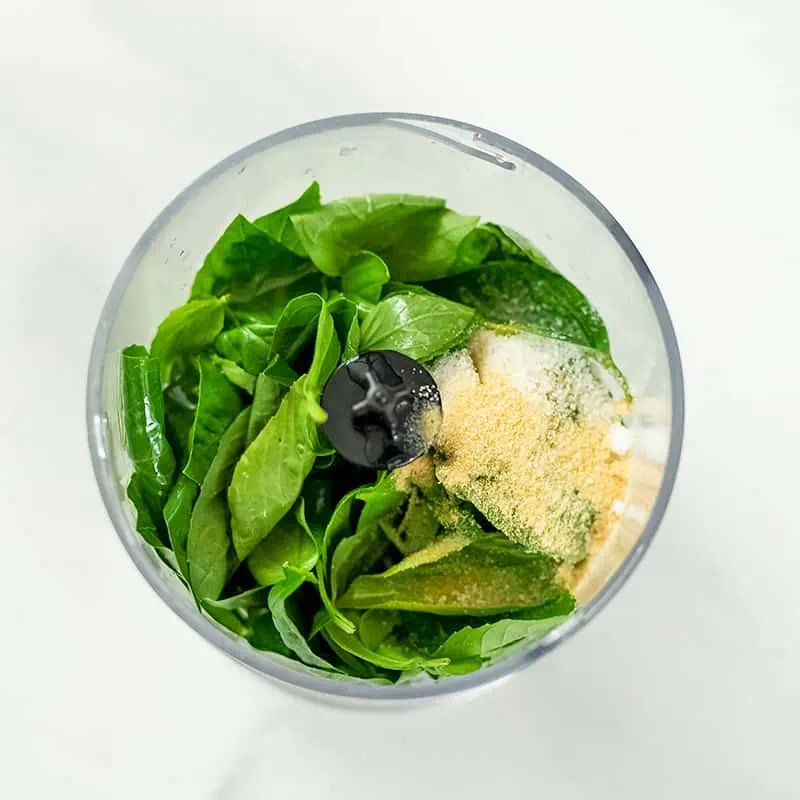
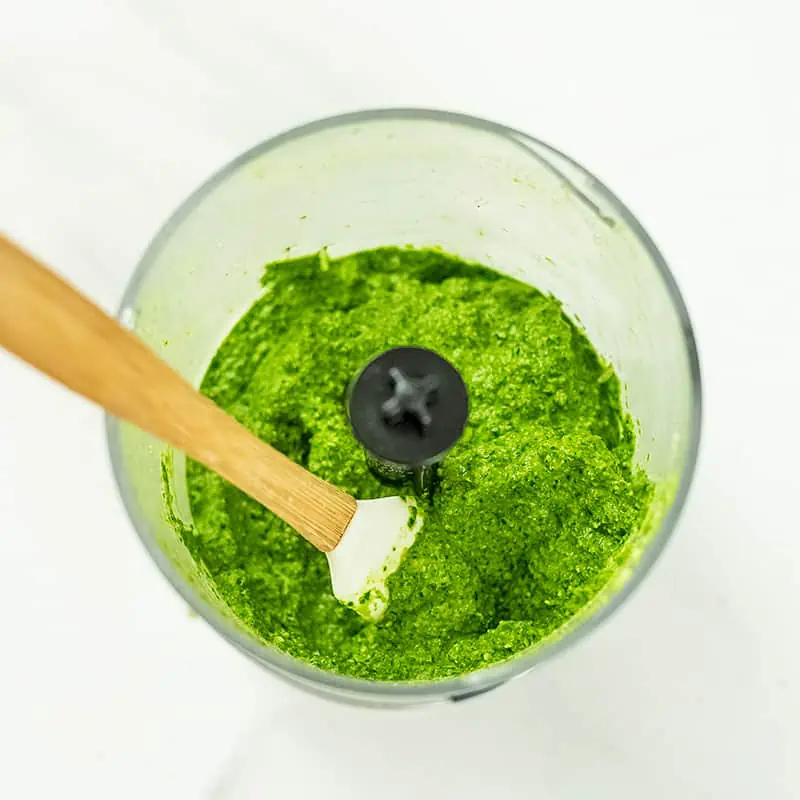
Chop the veggies into bite size pieces
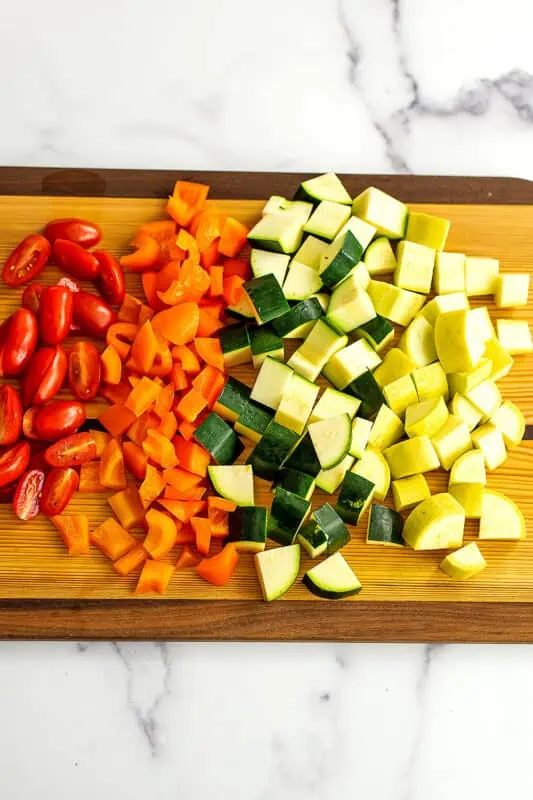
Cook the veggies

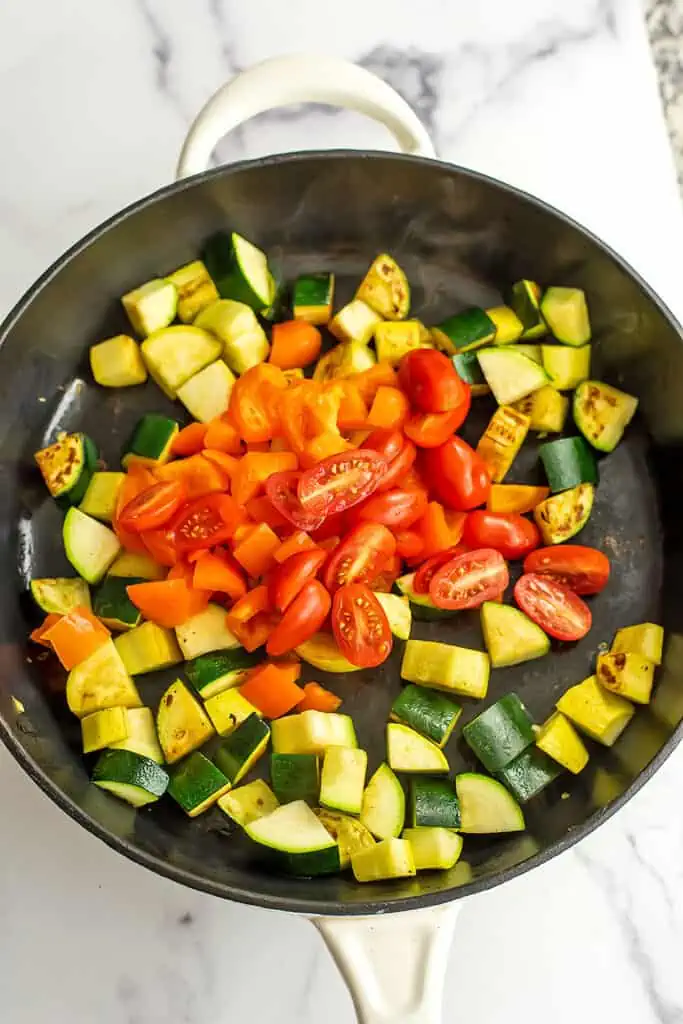
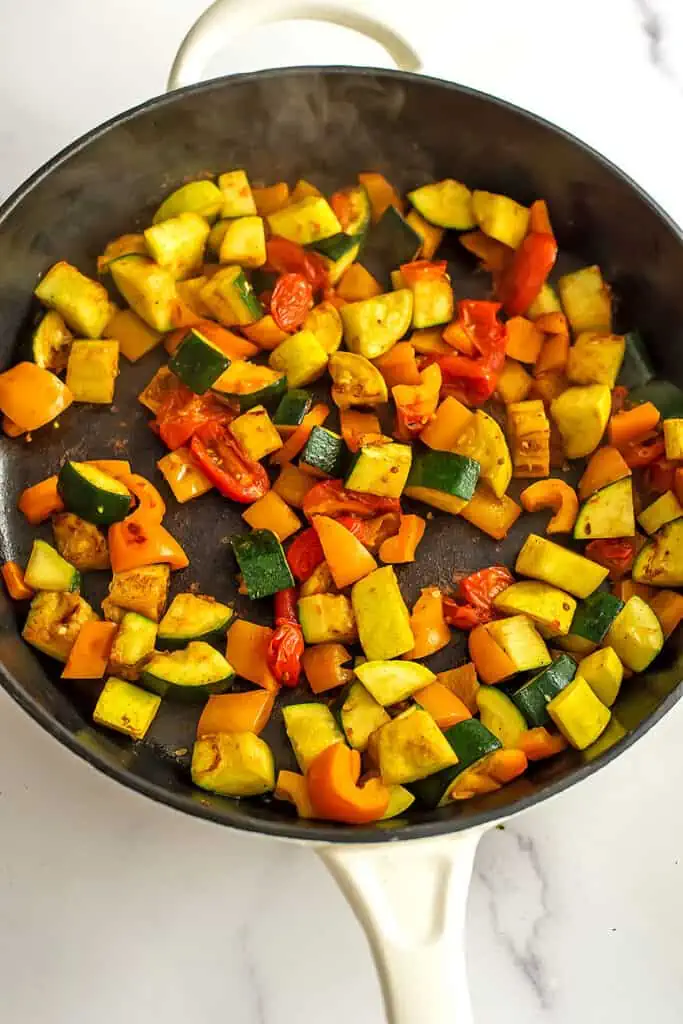
Cook the pasta, reserve pasta water before draining


Add chickpeas and pesto: Add chickpeas, pasta and pesto to the skillet with the veggies.
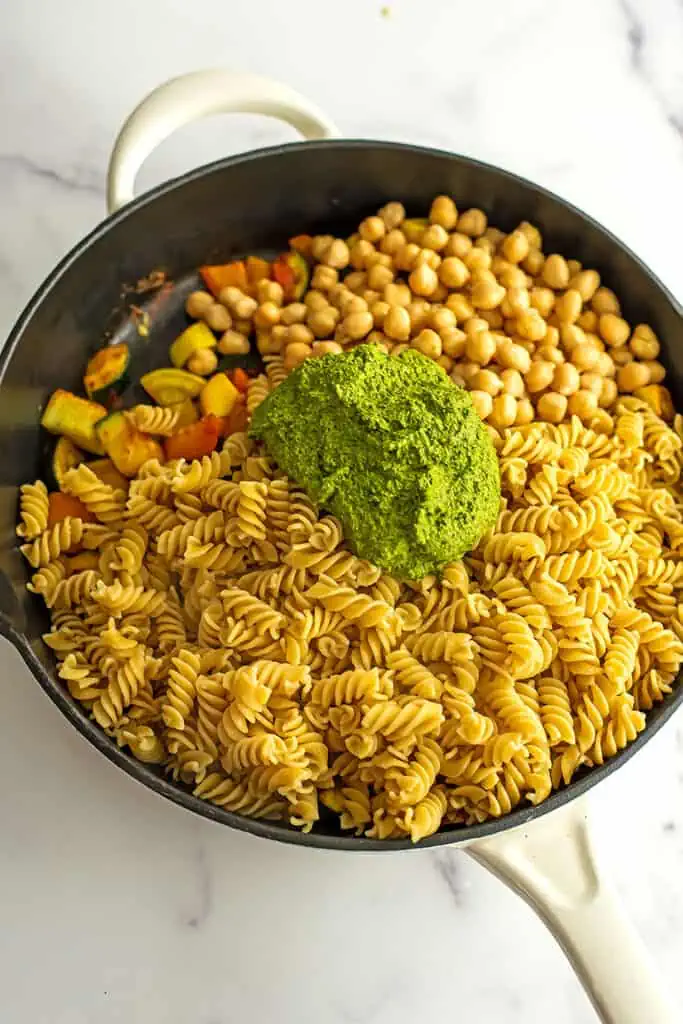

Check the sauce: Add about ¼ cup of the reserved pasta water, stir well. Add more if needed. Taste for salt (add more if needed) and serve hot, cold or at room temperature.
Top tips
- Use enough pesto – the star of this recipe is really the pesto, it’s what brings the flavor and makes it really delicious. I recommend using at least ¾ cup of pesto, but if you can get closer to 1 cup, that is ideal.
- Use pesto that you really love
- Be sure to reserve some of the pasta cooking water before draining it. The starchy water helps to create a super creamy pesto sauce that sticks to the pasta easily.
- I like to cut the zucchini and squash a little thicker for this recipe, but if you need them to cook even quicker, you can cut them a bit thinner.
- If you don’t have time to cook the veggies, I recommend using roasted red peppers, canned or jarred artichoke hearts (chopped), and fresh chopped tomatoes.
- Save time by making the homemade pesto in advance (or using store bought) and chop the veggies in advance. You can store chopped vegetables in the fridge in a airtight container for up to 4 days.
- Make this even more filling by adding in your favorite protein.
- Make this pesto veggie pasta lower in carbs, replace the pasta with spaghetti squash, zucchini noodles, or hearts of palm pasta.
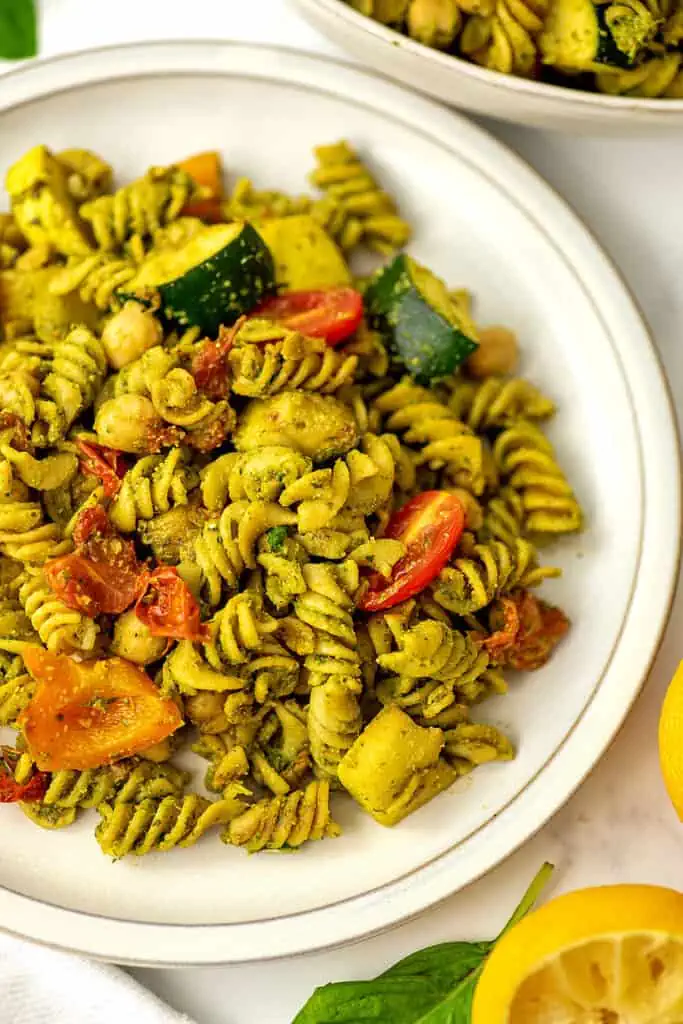
Other additions to pesto vegetable pasta
- Spice: Add a few shakes of crushed red pepper flakes
- Creaminess: Add some avocado, goat cheese, parmesan (regular or dairy free) or feta cheese (regular or dairy free)
- Protein: Add some shredded chicken, cubed chicken, salmon, shrimp or tofu
- Other veggies: Add broccoli (cook it in the last 2 minutes in the boiling pasta water), asparagus, artichoke hearts, mushrooms, spinach, kale, peas, eggplant
Common questions
What is the best pasta to use
For any meatless pasta meal, I love to use chickpea pasta or lentil pasta to add more protein and fiber. This helps to make it super filling and doesn’t change the flavor much. Look for chickpea pasta with just one ingredient (chickpeas) or lentil pasta with just one ingredient (red lentils or green lentils). I find these pasta are much easier to digest and don’t break apart as easily when cooking.
I love using rotini for pesto based dishes because the pesto sticks to all the little swirls around the pasta. Some other great shapes are:
- Fusilli
- Penne
- Farfalle (bow-tie)
- Elbow

Other pesto recipes to use
- Basil Sunflower Seed Pesto – this is made with roasted sunflower seeds, making it nut free
- Tahini pesto – this pesto is made with tahini, which gives it a creamy texture and it’s also nut free
- Pea Pesto (this is a little sweeter and such a great pesto for this dish in early spring)
- White bean pesto – this would make this pesto veggie pasta even more filling with the addition of the white beans
- Cashew Arugula Pesto – this recipe uses arugula, which as a more peppery flavor than spinach in the pesto
- Spinach Walnut Pesto – this recipe uses walnuts in place of the cashews
- Red Pepper Pesto – the roasted red peppers give this pesto a slightly sweet flavor.
What is the best store-bought vegan pesto
Personally I love the Cashew Arugula Pesto from Trader Joe’s. It’s made with really great ingredients and it’s pretty budget friendly. If you don’t have a Trader Joe’s around, you can pick up Seggiano Brand in Whole Foods (or online).
Some other great dairy free, vegan friendly pesto that you can buy online are from ROI and Compagnia Sanremo. These are less budget friendly than the Trader Joe’s pesto but are a great option if you are short on time.
Storing leftovers
- Fridge: Store leftover pesto vegetable pasta in the fridge in a well sealed container for up to 4 days. Note that the pesto will start to get darker in color the longer it sits. The color may change but the flavor will still be there. This is why I like to add baby spinach to help preserve the green color.
- You can enjoy the leftover veggie pesto pasta cold from the fridge (making it great for meal prep lunches), as room temperature or reheated (in the microwave 2-3 minutes or on the stove in a small skillet, covered over medium low heat with a tablespoon or two of water added).
- Freezer: I don’t recommend freezing this recipe as the veggies will get soggy when defrosting.
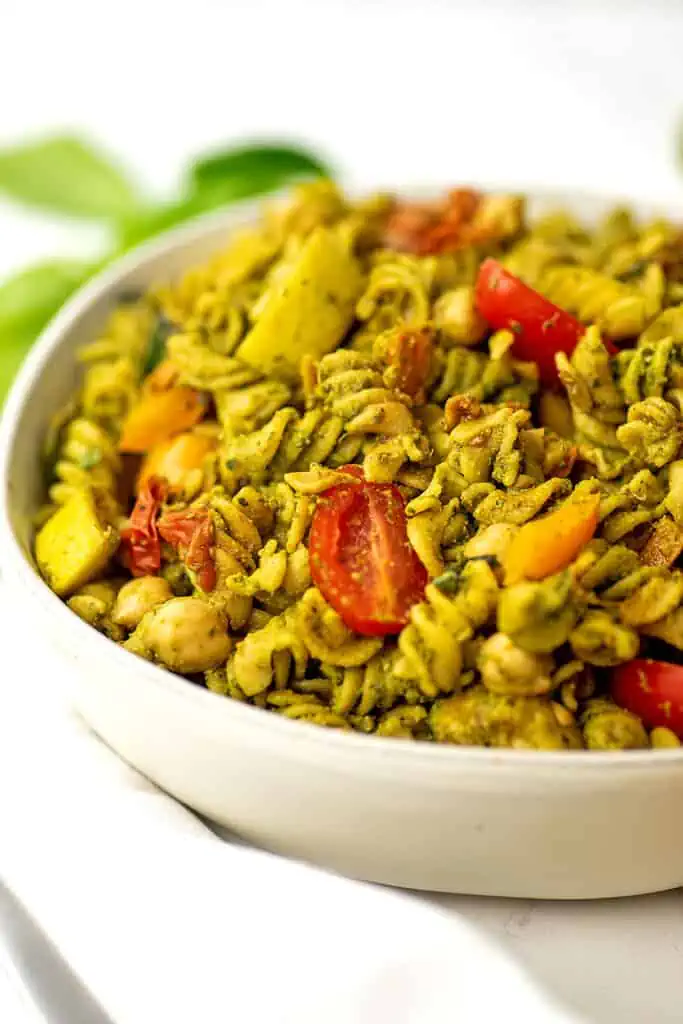
Substitutions
- Zucchini, yellow summer squash, bell peppers, tomatoes – use more or less of any of these veggies or any of the veggies listed above. In total you want 4-5 cups of chopped raw vegetables.
- Pasta – use whatever pasta you have on hand. If you don’t have pasta, you can use quinoa. To make this lower in carbs, use spaghetti squash, hearts of palm pasta or make zoodles (zucchini noodles).
- Chickpeas – use whatever white beans you have on hand including cannellini beans, great northern white beans, navy beans or butter beans (fava beans). If you don’t love beans, omit them.
- Pesto – use homemade or store bought pesto for this recipe. If you don’t have pesto, you can make this with creamy tomato sauce instead.
If you love this recipe, you should try
- Pesto Cauliflower Rice
- Sundried Tomato Pesto Pasta
- Pesto Crusted Salmon
- Artichoke Pesto Pasta
- Pesto Pasta Salad with Sun Dried Tomatoes
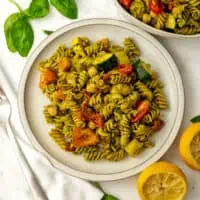
Pesto Veggie Pasta
Guided Recipe Video
Ingredients
- 2 medium zucchini squash
- 1 medium summer squash
- 1 medium bell pepper
- 1/2 cup tomatoes
- 12 oz pasta
- 1 can chickpeas
- 3/4 cup pesto
Spinach Cashew Pesto
- 1 cup fresh basil
- 2 tbsp olive oil
- 1 medium lemon, juiced
- 1/2 tsp sea salt
- 1/2 tsp garlic powder
- 1/4 cup cashews
- 1 cup baby spinach
Instructions
- Make the pesto by adding all the ingredients to a food processor and processing on high until thick and smooth (1-2 minutes, scrape down the sides if needed).
- Bring a large pot of water to a boil. Preheat a large skillet over medium to medium high heat.
- Chop the vegetables: cut the zucchini and yellow squash into 4 long pieces then chop into 1/2 inch pieces. Cut the bell pepper and tomatoes into bite size pieces.
- When the skillet is preheated, spray with olive oil or avocado oil and add the zucchini and squash. Cook for 4-6 minutes, stirring regularly.
- After 4-6 minutes, add the bell peppers and tomato the skillet with the zucchini and squash and cook 4-6 additional minutes. Turn off the skillet once the squash gets soft.
- When the water comes to a boil, add the pasta to the boiling water and cook until al dente.
- Right before draining the pasta, reserve about 1/2 cup of starchy pasta water.
- Add the pasta, rinsed and drained chickpeas and pesto to the skillet with the vegetables. Stir well.
- Add 1/4 cup of the reserved pasta water to the pasta. Stir well and add more of the pasta water if needed.
- Test for seasoning and add any additional salt if needed.
Notes
- Use enough pesto –use least ¾ cup of pesto, but if you can get closer to 1 cup, that is ideal.
- Use pesto that you really love
- Be sure to reserve some of the pasta cooking water
- I like to cut the zucchini and squash a little thicker for this recipe, but if you need them to cook even quicker, you can cut them a bit thinner.
- If you don’t have time to cook the veggies, I recommend using roasted red peppers, canned or jarred artichoke hearts (chopped), and fresh chopped tomatoes.
- Save time by making the homemade pesto in advance (or using store bought) and chop the veggies in advance. You can store chopped vegetables in the fridge in a airtight container for up to 4 days.
- Make this even more filling by adding in your favorite protein.
- Make this pesto veggie pasta lower in carbs, replace the pasta with spaghetti squash, zucchini noodles, or hearts of palm pasta.
- Fridge: Store leftover pesto vegetable pasta in the fridge in a well sealed container for up to 4 days.
- You can enjoy the leftover veggie pesto pasta cold from the fridge (making it great for meal prep lunches), as room temperature or reheated (in the microwave 2-3 minutes or on the stove in a small skillet, covered over medium low heat with a tablespoon or two of water added).
- Freezer: I don’t recommend freezing this recipe.


